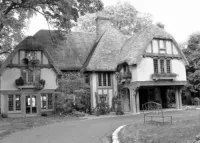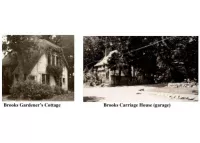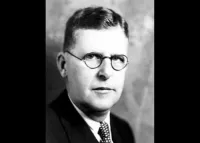Share what you know,
and discover more.
Share what you know,
and discover more.
Jun 01, 1919

-

- Dave D
History of Bushway Road and Its Neighborhood
Excerpt from the History of Bushway Road and Its Neighborhood (1858-2009) by Irene Stemmer, of the Wayzata Heritage Preservation Board (HPB) as a means of preserving the history of the Bushaway Road and its neighborhood. Brooks Family History Paul Brook’s grandfather, Dr. Sheldon Brooks. Sr. moved his family to Minnesota territory from New York in 1856 settling in Winona, Minnesota where he engaged in farming and practicing medicine. He also constructed grain elevators until his retirement in 1874. Dr. Brooks helped shape the early history of Minnesota by serving in the Minnesota House of Representatives 1859-60. He died in Winona in 1883. In 1896, Dr. Brook’s sons, Lester, Anson and Dwight, joined M. J. “Joe” Scanlon to open a sawmill in Nickerson, Minnesota, and by 1901 they had formed “The Brooks Scanlon Lumber Company” with sawmills in Minnesota, Oregon, Florida, Louisiana, Montana and British Columbia. Paul Brooks, owner of the Brooks house at 601 Bushaway, was the son of Anson Brooks. He joined his father in the lumber business as secretary of Brooks Scanlon Lumber Company. Paul Brooks was very interested in history and was an early board member of the Minnesota Historical Society. He had a strong interest in conservation and was involved in numerous conservation efforts and he was an amateur photographer receiving several awards for his work. Paul and Hazel Brooks had four children, Martha Pauline (Hollern), Sheldon Von Hagen (owner of Minnetonka Boat Works for 35 years), Barbara (Kroos), Stanley (Gregory) and Anson Brooks. Paul Brooks died in 1941 and his widow, Hazel, continued to own the lake home until her death in 1971. The house remained in the family until 1973 when it was sold to its present owner. Originally the estate extended across the road to Gray’s Bay. The acreage was later subdivided. The gardener’s cottage became 620 Bushaway Road and the cook’s cottage, razed in 2008, was at 581 Bushaway. The carriage house (garage) and chauffeur’s apartment 13 is located south of the gated driveway to the main house. The two photos pictured below were taken about 1919. Architect Harry W. Jones. Jones attended Brown’s College for two years and then transferred to MIT to study architecture. After graduating, he came to Minneapolis and worked for William Channing Whitney, also a prominent architect of homes around the lake (Highcroft, for one) before 14 opening his own office. When Jones found Minnesota to have a shortage of draftsmen and young architects to work in his office, he talked local university leaders into starting an Architectural Department at the University of Minnesota and was its first professor. By 1892, he had developed a syllabus that could compete with its east coast contemporaries. In 1893, he returned to his private practice until his retirement in 1933. Among his many architectural achievements were the Lakewood Cemetery Chapel, the first Minnetonka Yacht Club, Wayzata Congregational Church (still standing at Walker Avenue and Rice Street in Wayzata), Lake Harriet Pavilion, Scottish Rite Temple and numerous homes around Lake Minnetonka and churches throughout the state and country.
History of Bushway Road and Its Neighborhood
Excerpt from the History of Bushway Road and Its Neighborhood (1858-2009) by Irene Stemmer, of the Wayzata Heritage Preservation Board (HPB) as a means of preserving the history of the Bushaway Road and its neighborhood. Brooks Family History Paul Brook’s grandfather, Dr. Sheldon Brooks. Sr. moved his family to Minnesota territory from New York in 1856 settling in Winona, Minnesota where he engaged in farming and practicing medicine. He also constructed grain elevators until his retirement in 1874. Dr. Brooks helped shape the early history of Minnesota by serving in the Minnesota House of Representatives 1859-60. He died in Winona in 1883. In 1896, Dr. Brook’s sons, Lester, Anson and Dwight, joined M. J. “Joe” Scanlon to open a sawmill in Nickerson, Minnesota, and by 1901 they had formed “The Brooks Scanlon Lumber Company” with sawmills in Minnesota, Oregon, Florida, Louisiana, Montana and British Columbia. Paul Brooks, owner of the Brooks house at 601 Bushaway, was the son of Anson Brooks. He joined his father in the lumber business as secretary of Brooks Scanlon Lumber Company. Paul Brooks was very interested in history and was an early board member of the Minnesota Historical Society. He had a strong interest in conservation and was involved in numerous conservation efforts and he was an amateur photographer receiving several awards for his work. Paul and Hazel Brooks had four children, Martha Pauline (Hollern), Sheldon Von Hagen (owner of Minnetonka Boat Works for 35 years), Barbara (Kroos), Stanley (Gregory) and Anson Brooks. Paul Brooks died in 1941 and his widow, Hazel, continued to own the lake home until her death in 1971. The house remained in the family until 1973 when it was sold to its present owner. Originally the estate extended across the road to Gray’s Bay. The acreage was later subdivided. The gardener’s cottage became 620 Bushaway Road and the cook’s cottage, razed in 2008, was at 581 Bushaway. The carriage house (garage) and chauffeur’s apartment 13 is located south of the gated driveway to the main house. The two photos pictured below were taken about 1919. Architect Harry W. Jones. Jones attended Brown’s College for two years and then transferred to MIT to study architecture. After graduating, he came to Minneapolis and worked for William Channing Whitney, also a prominent architect of homes around the lake (Highcroft, for one) before 14 opening his own office. When Jones found Minnesota to have a shortage of draftsmen and young architects to work in his office, he talked local university leaders into starting an Architectural Department at the University of Minnesota and was its first professor. By 1892, he had developed a syllabus that could compete with its east coast contemporaries. In 1893, he returned to his private practice until his retirement in 1933. Among his many architectural achievements were the Lakewood Cemetery Chapel, the first Minnetonka Yacht Club, Wayzata Congregational Church (still standing at Walker Avenue and Rice Street in Wayzata), Lake Harriet Pavilion, Scottish Rite Temple and numerous homes around Lake Minnetonka and churches throughout the state and country.
Jun 01, 1919
History of Bushway Road and Its Neighborhood
Excerpt from the History of Bushway Road and Its Neighborhood (1858-2009) by Irene Stemmer, of the Wayzata Heritage Preservation Board (HPB) as a means of preserving the history of the Bushaway Road and its neighborhood.Brooks Family History Paul Brook’s grandfather, Dr. Sheldon Brooks. Sr. moved his family to Minnesota territory from New York in 1856 settling in Winona, Minnesota where he engaged in farming and practicing medicine. He also constructed grain elevators until his retirement in 1874. Dr. Brooks helped shape the early history of Minnesota by serving in the Minnesota House of Representatives 1859-60. He died in Winona in 1883.
In 1896, Dr. Brook’s sons, Lester, Anson and Dwight, joined M. J. “Joe” Scanlon to open a sawmill in Nickerson, Minnesota, and by 1901 they had formed “The Brooks Scanlon Lumber Company” with sawmills in Minnesota, Oregon, Florida, Louisiana, Montana and British Columbia. Paul Brooks, owner of the Brooks house at 601 Bushaway, was the son of Anson Brooks. He joined his father in the lumber business as secretary of Brooks Scanlon Lumber Company.
Paul Brooks was very interested in history and was an early board member of the Minnesota Historical Society. He had a strong interest in conservation and was involved in numerous conservation efforts and he was an amateur photographer receiving several awards for his work.
Paul and Hazel Brooks had four children, Martha Pauline (Hollern), Sheldon Von Hagen (owner of Minnetonka Boat Works for 35 years), Barbara (Kroos), Stanley (Gregory) and Anson Brooks. Paul Brooks died in 1941 and his widow, Hazel, continued to own the lake home until her death in 1971. The house remained in the family until 1973 when it was sold to its present owner.
Originally the estate extended across the road to Gray’s Bay. The acreage was later subdivided. The gardener’s cottage became 620 Bushaway Road and the cook’s cottage, razed in 2008, was at 581 Bushaway. The carriage house (garage) and chauffeur’s apartment 13 is located south of the gated driveway to the main house. The two photos pictured below were taken about 1919.
Architect Harry W. Jones.
Jones attended Brown’s College for two years and then transferred to MIT to study architecture. After graduating, he came to Minneapolis and worked for William Channing Whitney, also a prominent architect of homes around the lake (Highcroft, for one) before 14 opening his own office. When Jones found Minnesota to have a shortage of draftsmen and young architects to work in his office, he talked local university leaders into starting an Architectural Department at the University of Minnesota and was its first professor. By 1892, he had developed a syllabus that could compete with its east coast contemporaries. In 1893, he returned to his private practice until his retirement in 1933.
Among his many architectural achievements were the Lakewood Cemetery Chapel, the first Minnetonka Yacht Club, Wayzata Congregational Church (still standing at Walker Avenue and Rice Street in Wayzata), Lake Harriet Pavilion, Scottish Rite Temple and numerous homes around Lake Minnetonka and churches throughout the state and country.
Posted Date
Mar 19, 2022
Historical Record Date
Jun 01, 1919
Source Name
Wayzata Heritage Preservation Board
Delete Story
Are you sure you want to delete this story?












